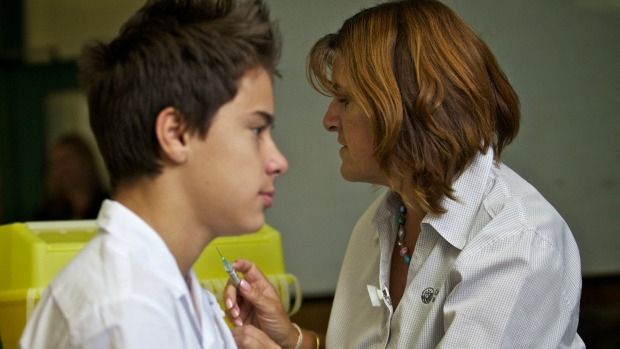
Returning: failure to ensure children are immunised, and given necessary second shots, are behind the rising number of measles cases worldwide.
What is happening?
Despite hopes in Europe that measles would be officially eradicated by 2015, there have been almost 4000 cases in the past year. A recent outbreak in Germany has resulted in 400 cases of measles in the past four months, with 254 recorded in January alone. In the United States, where the virus was declared “eliminated” in 2000, more than 100 cases have emerged this year. Most of the cases have been linked to unvaccinated adults and children, prompting debate about the steps necessary to ensure that individuals, schools, communities and countries are immune.
Measles is a highly contagious, airborne, respiratory virus that manifests in flu-like symptoms and a widespread rash. Complications include middle ear infections, pneumonia and encephalitis (brain inflammation). Two doses of measles mumps and rubella (MMR) vaccine, typically given at 12 months and again before a child begins school, are considered necessary for effective immunisation. A vaccination rate of 90 per cent or higher is considered necessary to achieve “herd immunity”; meaning the immunised majority limits the opportunities for disease to spread.
Why is it happening?
According to the World Health Organisation (WHO), Germany’s vaccination rate is one of the world’s highest: 97 per cent among one-year-olds. However, German experts say one-third of all vaccinated children lack sufficient immunisation: they do not receive the necessary second dose. Other theories are that unvaccinated adults who contracted the illness fell through an “immunisation gap” in the 1970s, making them vulnerable to the virus; while some have linked the outbreak to unvaccinated asylum seekers from Serbia, Bosnia and Herzegovina, places where immunisation programs were interrupted during the Yugoslav civil war in the 1990s.
In the United States, the outbreak has been attributed to an infected foreigner visiting Disneyland in California. However, many argue that an upward trend in the number of non-medical vaccine “exemptions” has played a part in its spread. While many countries require children to be vaccinated before they start school, vaccination exemptions may be obtained for medical, religious, or “personal belief” reasons.
Where is it happening?
In most European countries, school admission is a checkpoint for vaccination, and many school districts offer immunisation services. Both Canada and Britain have a high vaccination rate for measles — 95 per cent — although it is not a condition of school enrolment.
According to WHO data, the measles vaccination rate in the United States is 91 per cent; below that of many poorer countries such as Brazil (99 per cent), Tanzania (95 per cent) and Libya (98 per cent). While students enrolling in school must be vaccinated, individual states determine their own exemption laws. As a consequence, some states and school districts have inadequate coverage. The increased use of non-medical exemptions in recent years — which, according to research, tends to occur in “geographical clusters” — has resulted in some schools recording immunisation rates of 100 per cent, and others, as low as 60 per cent.
What about Australia?
Australian children must be immunised before commencing school, with some welfare entitlements linked to vaccination compliance. However, exemptions are also permitted on medical, religious or conscientious grounds. As of 2014, proof of immunisation must also be provided to childcare centres in NSW, with Victoria set to follow suit from 2016. Health authorities have expressed concern about the steady increase in the use of non-medical exemptions, echoing similar concerns in the United States and elsewhere.
Australia’s measles vaccination rate is 94 per cent, according to WHO figures, and in 2014 measles was officially declared “eradicated”, although small outbreaks do occasionally occur. In 2013, “varicella” (chicken pox) was added to the MMR vaccine (MMRV) and is now listed on the National Immunisation Program Schedule. Five of the eight cases of measles in Victoria since August last year were contracted by unimmunised children at a primary school.
What do supporters say?
It is widely argued that the risks posed by the diseases themselves far outweigh any vaccine side effects. According to Australia’s chief scientist, Professor Ian Chubb, the evidence in support of vaccination is “overwhelming”. He describes it as “one of the most successful and cost-effective health interventions known to humanity” and expresses disappointment that people continue to give credence to “debunked” vaccination theories. Some say the anti-vaccination movement thrives on ignorance and the peddling of unscientific, false and misleading information readily available online.
Others argue that unvaccinated children pose a threat to public safety and that a person’s belief system should not extend to potentially harming others. They say that vaccination exemptions should be given only for medical reasons. Some say schools should have the right to refuse unvaccinated children.
What about those opposed to vaccination?
Anti-vaccination campaigners claim that immunising children should be a personal choice rather than a civic duty. Many are generally mistrustful of information provided by governments or pharmaceutical companies and fear the potential side effects of the vaccines themselves.
In conclusion
The vaccination debate is highly volatile: some argue that it should be mandatory for all children before starting school and that non-medical exemptions — religious or conscientious — should not apply. Others say the “risk versus benefits” arguments are “not as clear-cut as we are routinely told” and that vaccination should always be a personal choice.
Others note that the vaccination debate is more prevalent in developed countries, where the serious nature of disease is not so apparent, and that this fosters a sense of complacency about immunisation. In this regard, they say, vaccines have become “victims of their own success”.
Links
National Centre for Immunisation Research & Surveillance (NCIRS)
Centre for Disease Control and Prevention – United States
